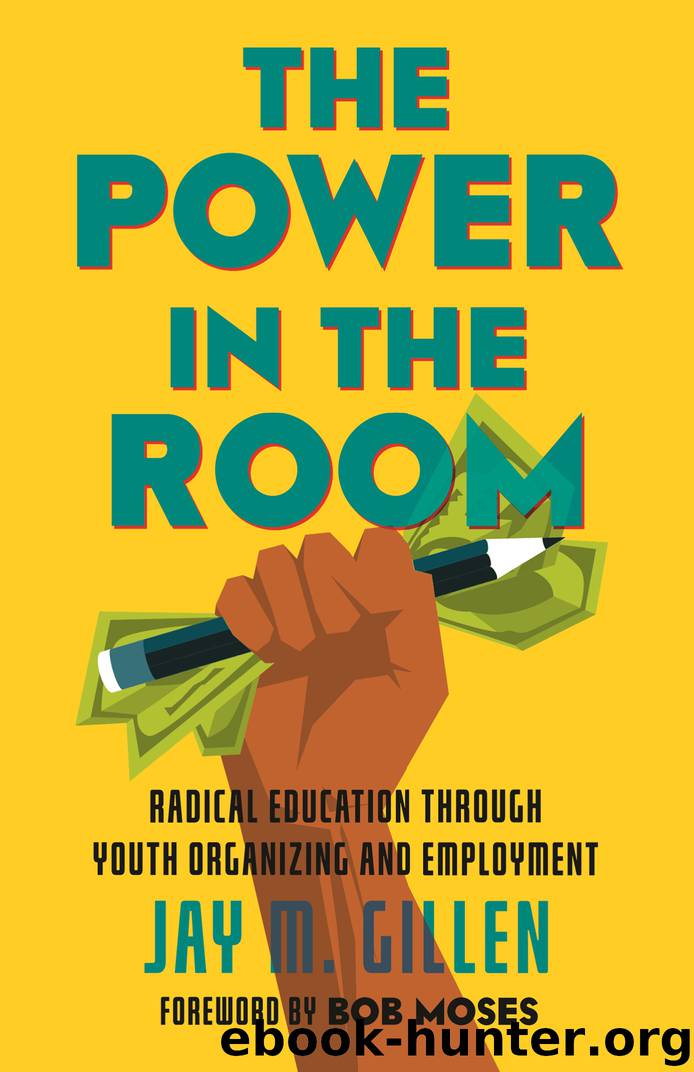The Power in the Room by Jay Gillen

Author:Jay Gillen
Language: eng
Format: epub
Publisher: Beacon Press
Published: 2019-03-11T16:00:00+00:00
PART II
RE-ROOTING EDUCATION
CHAPTER 4
An Educational Bureaucracy Built on Violence
Selections
My wife and I sit with our eighth grader in his school cafeteria, with many other parents and their eighth graders, for the annual introduction to Baltimore’s high school admissions process. An official shows slides with “composite scores” for the three or four “selective” high schools—some mysterious computation of weighted test scores, grades, and attendance required for admission. Our son wants to enroll in the high school his older brothers went to, but he will need a minimum composite score, we are told, of 620, whatever that means. Friends pass on the rumor that nothing less than a 680 would guarantee a place. What are our children thinking? Are their stomachs knotting up like ours?
In 2018 only ten Black students in a class of more than eight hundred were admitted to Stuyvesant High School, the selective public school in New York that my father graduated from in 1944, also with exactly ten Black students in his class.1 Today, the admissions-by-testing high schools in New York are 4 percent Black and Latinx, compared to 70 percent Black and Latinx students in the system’s population overall. A recent study commissioned by Baltimore’s school system determined that students who grow up in low-income census tracts are much less likely to qualify for the top-rated high schools.2 Another study of Baltimore City students showed that only 9 percent of students who entered high school in 2002 had earned any post-secondary college degree at all by 2011, either two-year or four-year, and virtually all of that 9 percent had attended one of three selective high schools.3
Yet another study from roughly the same period demonstrates that there is an almost nine-year difference in life expectancy for Baltimore residents with low educational opportunity compared to those with high educational opportunity: dying at age sixty-eight rather than at seventy-seven, on average.4 The adolescents sitting to the left and the right of us in the cafeteria, and our own Black son, are learning about a process of unscientific, arbitrary evaluations that correlate with scientifically well-documented results in terms of life and death, not to mention illness, incarceration, unemployment, and poverty. The children who must take the city bus because their parents can’t drive them to school, for example, have worse attendance than their peers—through no fault of their own—and so they have lower composite scores and less access to selective high schools, and they are expected to die almost a decade before their wealthier peers.
The selective high schools all across our country, the division into wealthy suburban and underfunded urban and rural jurisdictions, and the stratification of the country’s educational arrangements can hide neither the life-and-death consequences of their selectivity nor the arbitrariness of their process. In the precise location that is now the entrance to Baltimore’s baseball stadium, a slave market prospered for decades. Selections were made, prices negotiated, families separated, and human beings sold as property, many for transportation to sugar plantations down South where an early death was almost certain.
Download
This site does not store any files on its server. We only index and link to content provided by other sites. Please contact the content providers to delete copyright contents if any and email us, we'll remove relevant links or contents immediately.
| General | Discrimination & Racism |
Nudge - Improving Decisions about Health, Wealth, and Happiness by Thaler Sunstein(7517)
iGen by Jean M. Twenge(5347)
The Fire Next Time by James Baldwin(5219)
Adulting by Kelly Williams Brown(4458)
The Hacking of the American Mind by Robert H. Lustig(4290)
The Sports Rules Book by Human Kinetics(4254)
The Ethical Slut by Janet W. Hardy(4158)
Captivate by Vanessa Van Edwards(3780)
Mummy Knew by Lisa James(3605)
In a Sunburned Country by Bill Bryson(3464)
The Worm at the Core by Sheldon Solomon(3413)
Ants Among Elephants by Sujatha Gidla(3389)
Suicide: A Study in Sociology by Emile Durkheim(2959)
The 48 laws of power by Robert Greene & Joost Elffers(2948)
The Slow Fix: Solve Problems, Work Smarter, and Live Better In a World Addicted to Speed by Carl Honore(2929)
Humans of New York by Brandon Stanton(2791)
The Tipping Point by Malcolm Gladwell(2673)
Handbook of Forensic Sociology and Psychology by Stephen J. Morewitz & Mark L. Goldstein(2647)
The Happy Hooker by Xaviera Hollander(2640)
